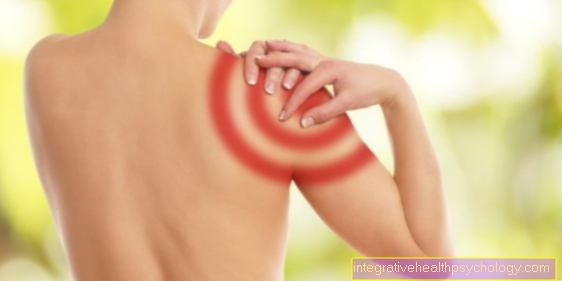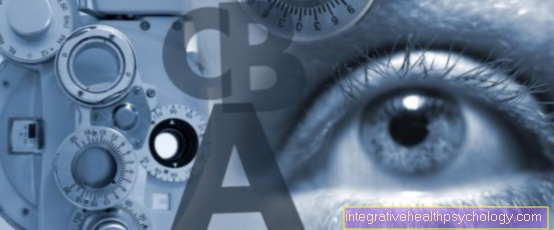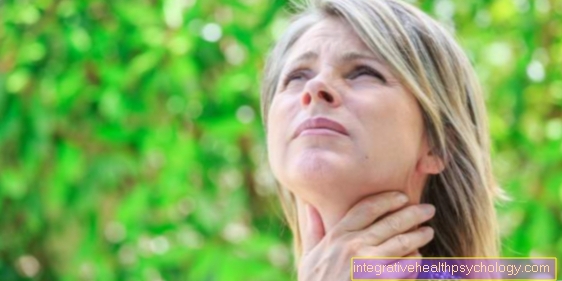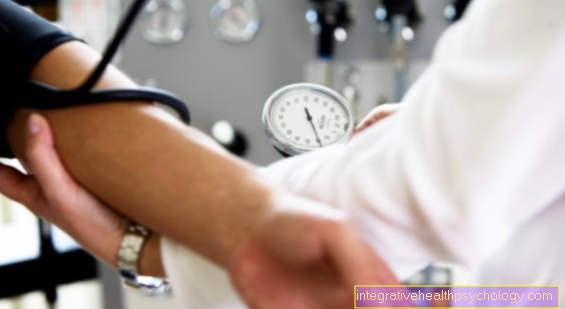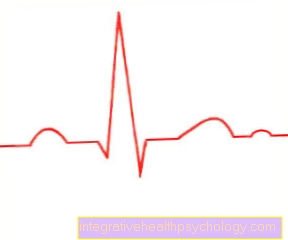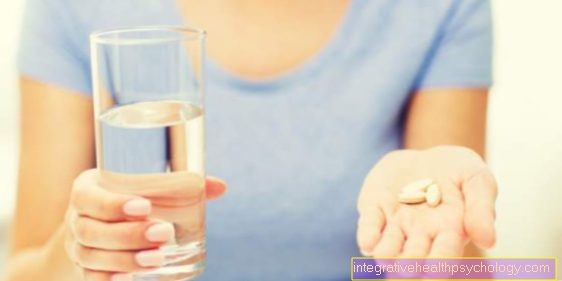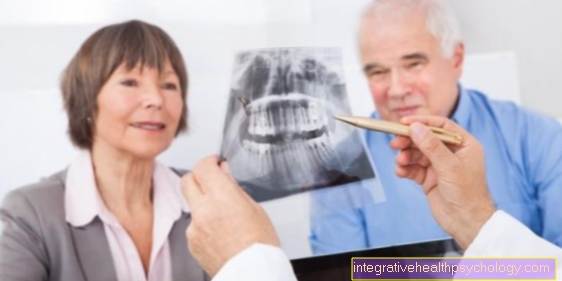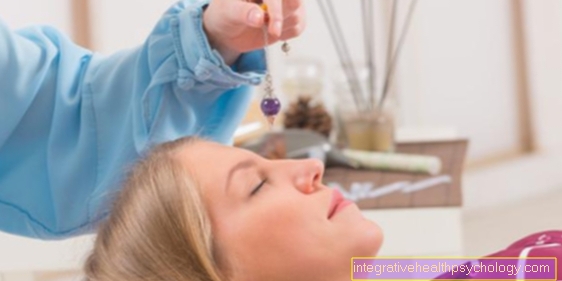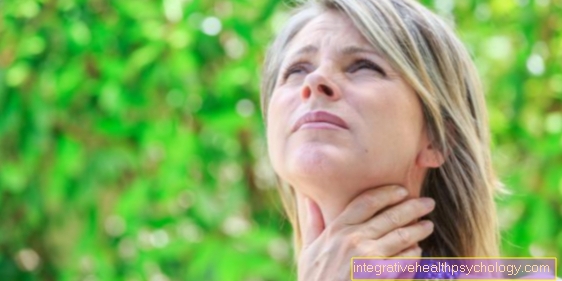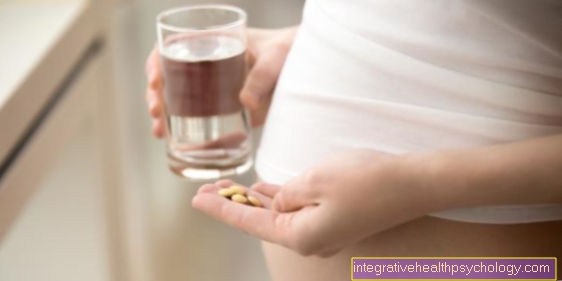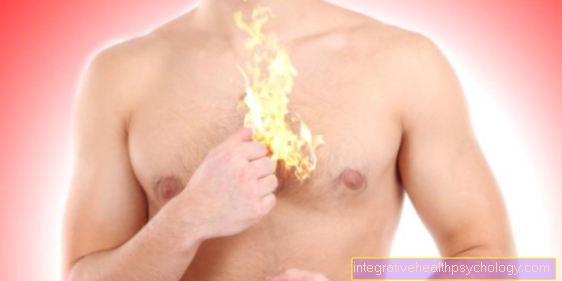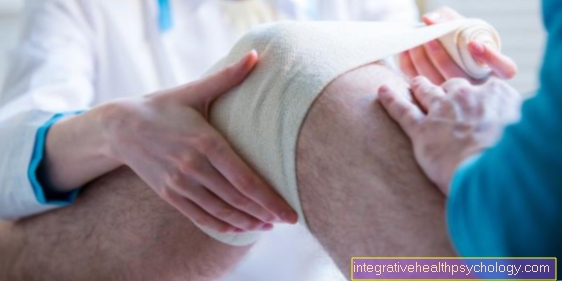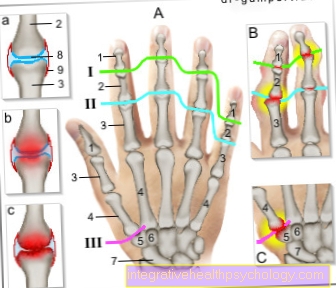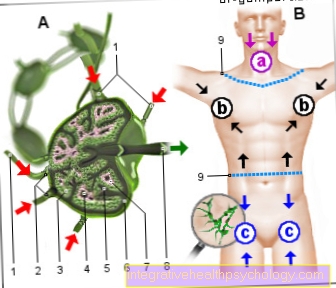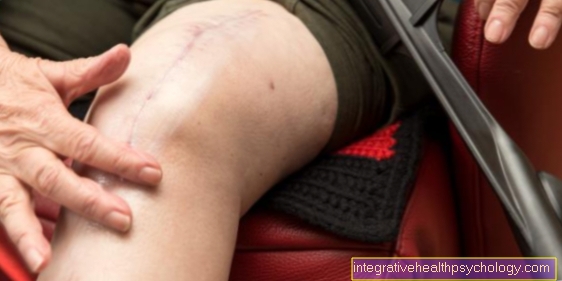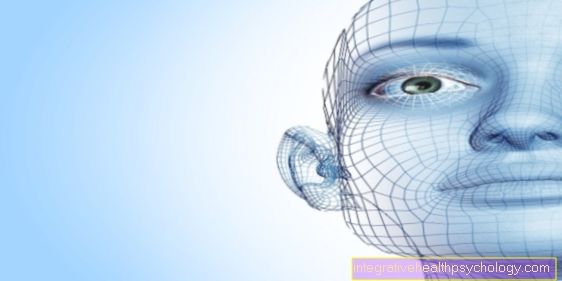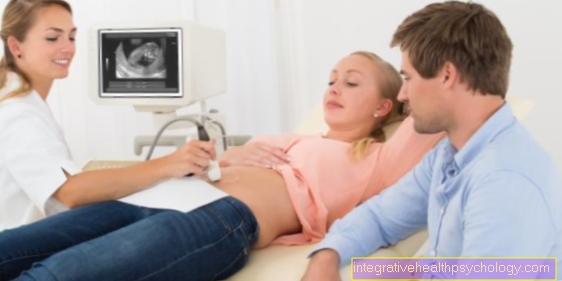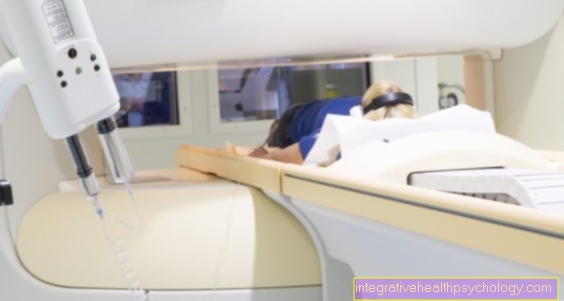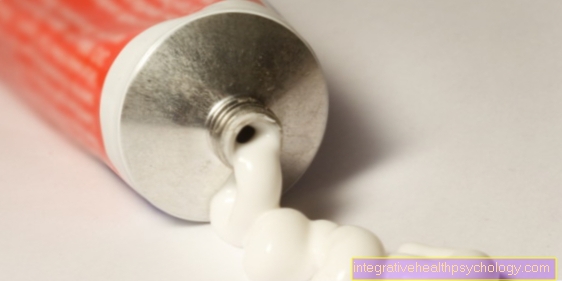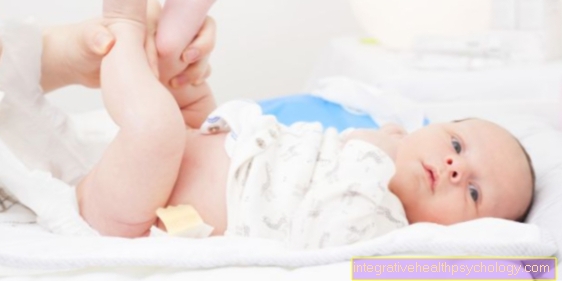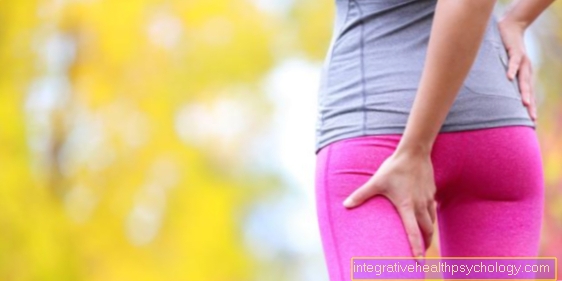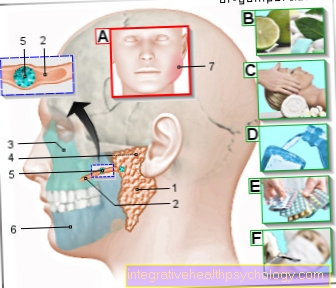Pain behind the kneecap
introduction
Pain behind the kneecap is a relatively unspecific symptom and cannot be clearly assigned to a disease. Often the pain is a sign of excessive strain or increasing wear and tear due to increased cartilage wear.
Radiological imaging is often necessary so that the doctor can make a reliable diagnosis.

The reasons
The kneecap is exposed to great forces during physical exertion, so that in the long run this can lead to cartilage damage behind the kneecap and even parts of the cartilage being rejected. This cartilage damage occurs mainly in athletes due to the great stress. If the patient is overstrained, cartilage damage can also result in patellar tip syndrome - an inflammation of the kneecap tendon.
In addition to excessive exercise, trauma or anatomical deviations (e.g. hip misalignments or knock knees) can also lead to cartilage damage. The cartilage behind the kneecap acts as a buffer and thus reduces the forces acting on the knee joint. If there is cartilage damage, a so-called patellofemoral pain syndrome often occurs.
The so-called plica syndrome can also cause pain. There are several folds within the knee (Plicae) the synovial membrane. If such a fold becomes thickened, for example as part of an inflammation, pain and restricted mobility usually occur as a result. In addition, there is an accumulation of fat behind the kneecap, known as Hoffa’s fat body referred to as. If you fall on your knee, this body of fat can tear or become infected if you put too much strain on it. In both cases there is sharp pain behind the kneecap.
Bones degenerate with age. Retropatellar arthrosis can develop in the knee area. It is not uncommon for the pain to appear in adolescence. This is due to rapid growth, which changes the direction of the kneecap tendon and the thigh muscle responsible for knee extension is not yet strong enough. Targeted training of this muscle usually helps.
The knee joint effusion as the cause
A cause of pain behind the kneecap can be a so-called knee joint effusion. This is an accumulation of fluid behind the kneecap within the joint capsule. The fluid can be synovial fluid, pus or blood.
Such effusions are caused in various ways. A common cause is ligament injuries in the knee area, for example a cruciate ligament tear. A dislocated kneecap or osteoarthritis, which often occurs in older people, are typical causes of knee joint effusion. The effusion leads to swelling of the knee, which often results in restricted mobility and pain accompanied. In addition, there may be redness in the knee area.
The knee joint effusion can be diagnosed with simple examinations. A possible diagnosis is then called “dancing patella” or “dancing kneecap”. If a "dancing patella" is diagnosed, the affected knee should be protected and positioned as high as possible.
Knee joint effusion - how dangerous is it? Read on here.
The cause of osteoarthritis of the kneecap
In addition to the thigh bone (femur) and the shin (tibia), the kneecap is the third joint partner of the knee. There is articular cartilage between the kneecap and the thigh bone. This is increasingly worn out by movement and pressure. When completely worn, the two bones lie directly on top of each other. This condition is called knee osteoarthritis. It is usually associated with severe pain.
By exerting pressure on the patella, for example when working on the knees, or by generally heavy stress on the knee, for example by lifting heavy loads, the kneecap is heavily stressed. Permanent stress can lead to osteoarthritis of the kneecap. In addition, knee osteoarthritis can also have anatomical causes. If the kneecap and thighbone do not fit properly, friction can occur, which ultimately leads to osteoarthritis. Runners in particular are at risk of knee osteoarthritis due to their high stress and movement of the knee.
Find out more about the topic here: The knee osteoarthritis.
Physical activity as the cause
During or after exercise, especially after jogging, knee pain can occur. These can have different causes. Typical causes are muscular imbalances in the thigh muscles, congenital leg deformities (so-called "bowlegs" or "knock knees") or instabilities of the hip and ankle joints.
In addition, an incorrect running style can lead to pain behind the kneecap. If you bend your knee too much while jogging, for example, and thus exert increased pressure on the kneecap, you can cause inflammation of the cartilage below the kneecap. This inflammation ultimately leads to a strong feeling of pain behind the kneecap and should be treated with relieving posture.
The patellar tip syndrome as the cause
Patellar tendinitis is an inflammation of the patellar tendon. The patellar tendon runs from the bottom of the kneecap to the top of the tibia.
Inflammation of the patellar tendon is usually caused by increased or unusual tensile stress on the tendon. Such inflammation often occurs in high-jumping sports such as volleyball or basketball and in long-distance runners.
The patellar tip syndrome can take on different dimensions and is therefore also divided into four degrees. Depending on the degree, the symptoms appear at rest or only under stress. The inflammation of the tendon is treated conservatively, i.e. without surgery. Physiotherapy, massages, bandages, stretching exercises as well as medication and ointments can improve the symptoms.
Read more on the following topic: The patellar tip syndrome.
Sinding-Larson's disease as the cause
Sinding-Larson's disease is a synonym for patellar tip syndrome. However, the term refers to the inflammation of the patellar tendon, especially in children and adolescents. This inflammation or injury to the tendon often occurs in the course of growth. As the tendon grows, small tears and inflammation can develop, which ultimately stimulate cartilage growth. The resulting pain comes from the tendon attachment of the lower kneecap.
More information on the topic Sinding-Larson's disease you'll find here.
The symptoms
In addition to the pain behind the kneecap, there is often a swelling of the knee joint and a grinding, rubbing sound on examination. If this triad of symptoms occurs, it can be interpreted as a sign of retropatellar cartilage damage (= cartilage damage behind the kneecap). The pain that occurs is often dull and diffuse, so that the person affected cannot clearly localize it. The pain usually increases with exercise. Even with normal movements such as climbing stairs or crouching. These complaints in everyday activities are typical for diseases that relate to the kneecap. In some cases, the patients also describe an increasing stiffness of the knee.
If, in addition to the cartilage damage, there are still free pieces of cartilage in the joint, this often results in a restriction of movement, since the joint is blocked by the piece of cartilage and causes pain behind the kneecap.
Read more on the topic: Pain in the knee.
When bending or stretching
At the Bow and stretch great forces act on the knee Kneecap one, making it common with these movements too Pain behind the kneecap comes. If a person did not have a kneecap, it would hardly be possible to stretch the leg.
When climbing stairs
Pain behind the kneecap do not only occur during physical activity. Especially when climbing stairs or going downhill, the knee is bent on the one hand and is at the same time exposed to increased pressure compared to normal running, so that patients, for example, with a Cartilage damagefeel pain, especially when climbing stairs. When climbing stairs, there is an increased pull on the Kneecap and the Kneecap tendon.
Under pressure
Typical for Knee pain is that these usually occur during exertion, when there is greater pressure on the knee, while the pain is no longer present during rest.
To go biking is usually a sport recommended for those with knee problems because it moves the knee, but no great forcesuch as being suspended while jogging. However, if there is a so-called "Runner's knees"Before, in which the inflammation of a large tendon plate (Iliotibial band) has come, it can take a long time To go biking or to jog cause discomfort in the area of the kneecap. These tendons glide over the joint when the leg is bent and stretched, which happens at high frequency when cycling, and is correspondingly painful if there is inflammation.
The diagnosis
The doctor first examines the knee clinically in order to see what structure the cause is likely to lie in or to specifically check when the pain is greatest. Another step is often an ultrasound scan, which can be used to check whether a tendon has thickened or inflamed. Inflammation often causes a knee joint effusion (fluid accumulation in the knee joint), which can be detected using ultrasound. In some cases, an X-ray or even an MRI examination must be consulted for diagnosis, for example to infer cartilage damage or ligament damage.
For example, there is an increased suspicion of cartilage damage, which often leads to pain behind the kneecap, if the clinical examination reveals audible rubbing of the kneecap, as in this case there is increased bone rubbing on bone and not through protective cartilage separated from each other.
Calcifications, e.g. if you have chronic tendinitis, can be determined with an X-ray.
Read more on the topic: MRI of the knee
Appointment with a knee specialist?
I would be happy to advise you!
Who am I?
My name is dr. Nicolas Gumpert. I am a specialist in orthopedics and the founder of .
Various television programs and print media report regularly about my work. On HR television you can see me every 6 weeks live on "Hallo Hessen".
But now enough is indicated ;-)
The knee joint is one of the joints with the greatest stress.
Therefore, the treatment of the knee joint (e.g. meniscus tear, cartilage damage, cruciate ligament damage, runner's knee, etc.) requires a lot of experience.
I treat a wide variety of knee diseases in a conservative way.
The aim of any treatment is treatment without surgery.
Which therapy achieves the best results in the long term can only be determined after looking at all of the information (Examination, X-ray, ultrasound, MRI, etc.) be assessed.
You can find me in:
- Lumedis - your orthopedic surgeon
Kaiserstrasse 14
60311 Frankfurt am Main
Directly to the online appointment arrangement
Unfortunately, it is currently only possible to make an appointment with private health insurers. I hope for your understanding!
Further information about myself can be found at Dr. Nicolas Gumpert
The therapy
Therapy for pain behind the kneecap usually consists of a conservative, non-surgical therapy. There are several therapy methods to choose from, which are often used in parallel. On the one hand, anti-inflammatory and analgesic medication can be used if the pain is otherwise unbearable. Pain relieving ointments such as Voltaren® are often used for this. In the case of inflammation of the tendon insertion, local injections with painkillers play a major role, which usually provide immediate relief.
Furthermore, cold in the form of ice packs can improve the symptoms. In order to alleviate the symptoms not only in the short term, exercises for targeted muscle training can be used as part of physiotherapy in order to relieve the knee joint itself so that the muscles can absorb the force. Muscle training primarily trains the muscles of the thigh, as these are the best way to stabilize the knee.
In addition to physiotherapy, the orthopedic surgeon can also prescribe treatments such as ultrasound, electrotherapy or manual therapy. Many athletes also like to wear knee bandages during the illness phase, as they stabilize the joint and also relieve pain. They are also advised to rest their knees for a certain period of time or to significantly reduce the workload so that regeneration can take place. The rest should often take place over a period of eight weeks. If there is no need for complete immobilization, sports such as swimming or cycling are cheap alternatives.
In the case of a kneecap dislocation, immobilization with a bandage or orthosis is often indicated. This is followed by muscle-building therapy. If you have problems with knee problems, you should avoid high shoes and hard soles. Obesity is also a risk factor, so weight reduction should be considered.
If the treating orthopedic surgeon detects cartilage damage, this can be repaired with the help of a minimally invasive procedure (knee arthroscopy = knee joint mirroring), for example by smoothing the cartilage. If parts of the cartilage have broken off, these can also be removed from the joint as part of the arthroscopy. If a patient suffers from repeated dislocations of the kneecap, the loosened holding band of the kneecap can be surgically replaced with the help of an endogenous tendon and the knee can be stabilized again.
The exercises
The exercises, which can be done independently at home, are primarily aimed at strengthening the thigh muscles. Another effect is that the knee is increasingly supplied with blood and consequently the cartilage is also better supplied with blood, which itself does not have its own blood vessels, but is supplied with nutrients via diffusion. One exercise that primarily benefits the cartilage is performing the squat. The arms should be stretched forward and the knees should not protrude beyond the tips of the feet.
It is important, however, and this applies to all exercises, that you do not overload the knee with the exercises. Cycling is also good for the knee. The knee is moved, but not subjected to excessive pressure. Other exercises that can be done at home include:
let the knee swing while sitting. Above all, this promotes the formation of synovial fluid. Stretching out the knee while sitting and holding it for a while also has a beneficial effect on the thigh muscle, through which the knee can be relieved. Furthermore, to strengthen the thigh muscle (Quadriceps) put one leg at the ankle in a sling (for example a towel) and slowly pull it up through the arms. This exercise stretches the quadriceps and stabilizes the knee joint over time. It is also cheap to do a lunge. This position is then held for some time while small rocking movements are made at the same time.
Can a knee brace help?
Knee braces are often recommended for pain behind the kneecap or general pain in the knee area. These bandages are intended to provide additional stability and pain relief within the knee joint. This can prevent muscular imbalances and instabilities within the knee joint. It also supports the kneecap so that it can usually no longer dislocate.
In addition to the bandages, physiotherapy is always recommended to strengthen the development of the muscles in the thigh and knee area.
Prognosis
Since the pain behind the kneecap is triggered by various factors, it is not possible to formulate a general prognosis. The pain can often be reduced or completely eliminated through physiotherapeutic treatment, which primarily strengthens the muscles in order to relieve the knee.
A short break from training is often enough to give the knee time to regenerate. If there is cartilage damage, the damage and thus the pain can usually be repaired by means of a knee joint specimen (arthroscopy).
Read more on the topic: Knee arthroscopy.

